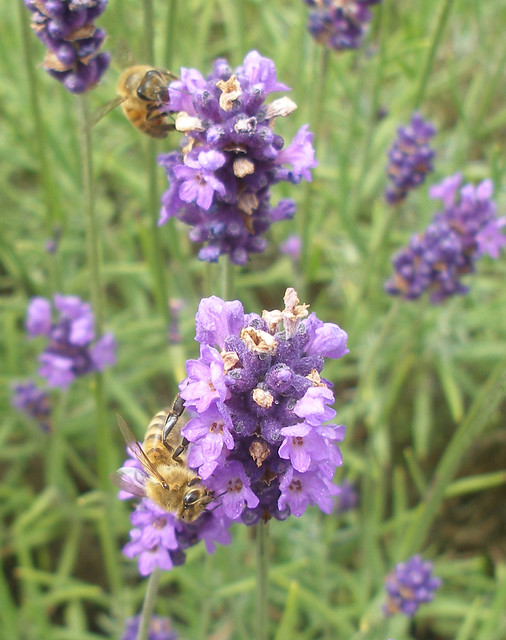Bees are having a hard time. Pathogens, insecticides and loss of habitat are all thought to be contributing to a decline in their numbers. Now a potential new threat has been added to the “perfect storm” threatening these insects. A group at Southampton University recently reported that diesel exhaust could be affecting the ability of honeybees to detect oilseed rape. The work was widely reported in the press with headlines such as “Bees losing sense of smell because of traffic fumes”, “Diesel fumes confuse honeybees when foraging” and “Bees can’t sniff out flowers because of CARS: diesel fumes change the odour of blooms and could cause a global food crisis”
The report seemed to be at odds with the view that bees flourish in urban environments so I thought I should take a closer look. The work was lead by Prof Guy Poppy, an ecologist and Dr Tracey Newman, a neuroscientist. Their basic premise was that because honeybees use floral odours to find, identify and recognise flowers for forage, anything that interferes with this process may affect the ability of bees to forage and may impair survival. Diesel exhaust might interfere with detection of these floral odours so that’s what they investigated.
What they did was to create a synthetic odour corresponding to the principal chemicals in the fragrance detected by bees from oilseed rape flowers. They used this synthetic odour to examine the effects of diesel fumes and found major effects. Within a minute, two of the component chemicals were completely destroyed when the synthetic odour was mixed with diesel exhaust. The reactive species in diesel exhaust thought to be responsible for these kinds of effect are nitrogen oxides, so next they mixed the synthetic odour with a mixture of nitrogen oxides chosen to mimic levels in diesel exhaust. The same two chemicals were destroyed by the nitrogen oxides. Finally, they checked to see if these effects of diesel exhaust made any difference to the bees. Using immobilised forager honeybees trained to recognise the synthetic odour, they showed that depletion of the two chemicals lead to a ~70% reduction in detection of the odour by bees.
Superficially, this sounds very clear: diesel fumes destroy chemicals in the synthetic odour and, as a result, bees lose the ability to detect the odour. This could have major knock-on effects for bees’ survival. However, before I add diesel exhaust to my list of bee threats, I want to be assured that this study is relevant to real roadside situations or locations where oilseed rape is grown.
It’s here that the study runs in to some problems. The diesel exhaust used in the experiments came directly from a diesel generator. Helpfully, the paper gives the figures for the levels of nitrogen oxides in the exhaust and it turns out that it contained nitrogen oxides ~200 times higher than the ambient levels recommended in the EU and US. The levels in the exhaust are also ~200 times higher than those found in inner London and ~2000 times higher than in remote rural locations in the UK. Because the levels of nitrogen oxides in the exhaust are so high, I don’t believe these experiments are relevant to real roadside situations.
The Southampton group did also test lower levels of nitrogen oxides and found lower effects (the key chemicals were both reduced by about half using levels of nitrogen oxides corresponding to inner London). I can’t, however, see any experiments in the paper on detection by bees of a synthetic odour depleted of the two chemicals by ~50%.
So, at improbably high nitrogen oxide levels, the loss of odour chemicals may hinder bees detecting the floral odour but we don’t know what happens when only 50% is lost and this is the condition that corresponds to ambient air recommendations and incidentally to levels found by roads in inner London. Without this information, I don’t believe it’s possible to conclude anything about the effects of typical inner city roadside levels of nitrogen oxides on detection of floral odours by bees; the study does not, therefore, warrant the dire newspaper headlines about effects of diesel fumes on bees. It’s also worth pointing out that most oilseed rape is not grown near inner city roads but in the countryside. Levels of nitrogen oxides and effects on bee foraging in these rural locations are likely to be lower still.
Perhaps it’s useful to reiterate the fact that bees do flourish in urban environments despite some pollution from vehicle fumes suggesting that they are not greatly affected by these pollutants.


I think the bees benefit more from the heat island effect in cities; earlier and longer flowering must help them. It’s just up to us gardeners to make sure that we have a good range of nectar-rich plants for them throughout the season. And, yes, I do grow lavender as well.
I agree about the heat island effect and the flowering period. The range of forage is also better in towns as you imply and in the countryside the monoculture is a real problem for insects. Also some cities e.g. Paris are pesticide free.
Glad to hear about the lavender!